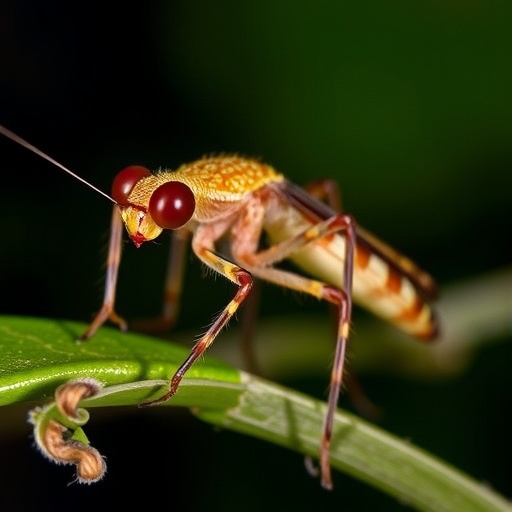In a groundbreaking study published in “Discover Forestry,” researchers have delved into the genetic divergence of the tropical tree species Parkia platycephala, a member of the Fabaceae family. This plant, commonly known for its large fruits and seeds, has significant ecological and economic value, particularly in its native regions. The importance of understanding the genetic variation within and among populations of this species is crucial, especially in the context of biodiversity conservation and sustainable forestry practices.
The study, led by de Sousa et al., focused on morphometric analysis of fruits and seeds as potential indicators of genetic divergence. Morphometry, the study of the form and structure of organisms, can reveal insights about the adaptability and evolution of species over time. By examining the size and shape of fruits and seeds, researchers can gather information about genetic differences that may exist among various populations of Parkia platycephala. This type of research is vital for informing conservation strategies and ensuring that ecological integrity is maintained across diverse habitats.
One of the key findings of the study is that fruit and seed morphology can serve as reliable indicators of genetic variance. The researchers meticulously collected samples from different populations, noting the distinct characteristics of the fruits and seeds based on their geographical locations. This approach not only highlighted the physical variability within the species but also expanded the understanding of how environmental factors may influence genetic diversity. The utilization of morphological traits in assessing genetic divergence presents a powerful tool for researchers aiming to conserve plant species and their habitats.
The study emphasizes the significance of seeds in tropical ecosystems, as they are integral to the regeneration processes of forests. The morphometric traits of seeds often correlate with reproductive success and survival rates, making them a focal point for understanding evolutionary dynamics. By analyzing the genetic divergence of Parkia platycephala through seed morphology, the researchers were able to establish a clear connection between phenotypic traits and genetic information, offering a comprehensive view of the species’ adaptability to its environment.
Morphological examination isn’t merely an academic exercise; it has real-world implications for conservation. As climate change accelerates, understanding the genetic health of a species becomes paramount. Parkia platycephala serves as a prime example, as its survival hinges on the genetic diversity that supports resilience to environmental changes. The findings from de Sousa and colleagues suggest that maintaining genetic variation within populations may be critical for the species’ long-term survival.
Furthermore, the research positions itself at the intersection of traditional knowledge and modern scientific inquiry. By engaging local communities and utilizing their understanding of the species, researchers were able to supplement their findings with practical insights that enrich the scientific narrative. The collaboration between scientists and indigenous knowledge holders helps ensure that conservation strategies are culturally relevant and more likely to be accepted by communities that rely on these resources.
As the guardians of biodiversity, researchers are increasingly aware of the complexities involved in preserving species like Parkia platycephala. The trend towards integrative approaches is essential in conservation science, combining genetic analysis with ecological data and local knowledge. This paradigm shift enables a more holistic understanding of species and their interactions with ecosystems, paving the way for more effective management policies.
The advances in molecular techniques, such as DNA sequencing and genetic markers, are revolutionizing the field of plant genetics. The ability to analyze genetic material at a granular level affords researchers deeper insights into population structure and adaptive potential. In the case of Parkia platycephala, this research underscores the importance of integrating morphological and genetic data to paint a complete picture of the species’ health and evolutionary narrative.
Additionally, the study opens up discussions about the role of fruit and seed morphometry in ecological interactions. For example, larger seeds may be favored in specific environments due to better survival rates in harsh conditions, while smaller seeds could disseminate more easily in other settings. These dynamics highlight the interplay between morphology and ecological adaptation, reinforcing the need for continued research into the drivers of diversity within plant populations.
The findings from the study also have implications for agroforestry and reforestation projects, where Parkia platycephala has notable utility. Understanding the genetic factors that enable specific populations to thrive can inform seed selection for restoration initiatives. Such efforts could yield stronger, more resilient ecosystems, benefitting both biodiversity and community livelihoods.
In conclusion, the research conducted by de Sousa et al. provides a powerful lens into the genetic world of Parkia platycephala. By utilizing fruit and seed morphology as indicators of genetic divergence, the study adds a valuable dimension to the conservation dialogue surrounding this important species. The implications of these findings extend beyond academia, touching on themes of environmental resilience, community involvement, and the fundamental relationships between species, their genetic makeup, and their habitats.
As the scientific community continues to explore the intersections of genetics, morphology, and ecology, the work of these researchers serves as a testament to the potential for comprehensive, collaborative approaches to understanding and protecting our planet’s biodiversity. The legacy of research like this lies not just in the academic literature but in the tangible, positive impacts it can have on conservation practices and the sustainability of our natural environments.
Subject of Research: Genetic divergence analysis in Parkia platycephala through fruit and seed morphometry.
Article Title: Genetic divergence analysis in Parkia platycephala Benth.: fruit and seed morphometry as indicators within and among populations.
Article References:
de Sousa, M.B., da Silva, C.L., da Silva Santos, P.C. et al. Genetic divergence analysis in Parkia platycephala Benth.: fruit and seed morphometry as indicators within and among populations.
Discov. For. 1, 17 (2025). https://doi.org/10.1007/s44415-025-00019-y
Image Credits: AI Generated
DOI:
Keywords: Parkia platycephala, genetic divergence, morphometry, biodiversity, conservation.




